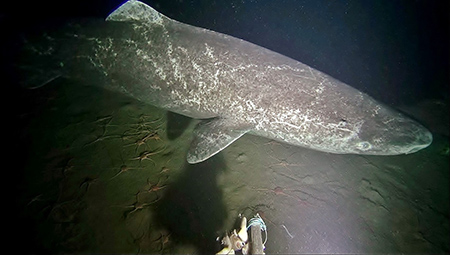Marine Institute study reveals first estimates of Greenland shark abundances in Arctic waters
A new study by scientists from the Fisheries and Marine Institute (MI) of Memorial University of Newfoundland provides the first local abundance estimates of one of Earth’s largest and longest-lived, yet most elusive, marine species: the Greenland shark.
The peer-reviewed study was published today in the journal Scientific Reports.
One of very few polar shark species, the Greenland shark is found throughout the cold waters of the North Atlantic Ocean and the Arctic Ocean. It is the largest fish in the Arctic and a top predator.
The MI study provides the first data and the local and regional abundance estimates of Greenland shark, independent of fishing and bycatch estimates. The findings are a first step toward fulfilling a major knowledge gap currently preventing assessment of population status needed for the management of the species.
The findings come from areas largely within the recently identified boundaries of what could become Canada’s largest marine protected area within the National Marine Conservation Area in Lancaster Sound, a region known locally as Tallurutiup Imanga.
Baited underwater cameras
The study’s lead author, PhD candidate Brynn Devine, oversaw the deployment of baited remote underwater video cameras into the deep, cold waters of Nunavut in the eastern Canadian Arctic.
Ms. Devine analyzed more than 258 hours of high resolution video data to derive abundance estimates. Surprisingly, Greenland sharks arrived at 80 per cent of the 31 deployments, with spatial variation in local densities and 142 individual sharks identified using unique markings on their skin. Additional data, including shark lengths and swimming speeds, were obtained from the video footage using integrated reference lasers on the camera for scale.
“We observed a wide range of shark sizes, from lengths well over three metres to quite small sharks, less than 1.5 metres in one particular region,” Ms. Devine said. “Although remarkably, based on our present understanding of the minimum size at maturity for this species, none of the sharks we observed were likely old enough to reproduce.”
Observation rates of individuals were compared among regions, and using estimates of swimming speed, current speed, and the time it took for the first shark to arrive, theoretical local densities of the number of sharks per square-kilometre were calculated using an existing model specific for video data. These local densities, combined with average mass of sharks based on length-weight relationships, enabled calculation of potential biomass estimates within each region.
Frontier of scientific understanding
The successful deployment of baited underwater video cameras in the Arctic demonstrates how minimally invasive technologies can be used to estimate deep water populations in areas at the frontier of scientific understanding and in areas undergoing changes in ocean conditions.
The research was undertaken in collaboration with the Arctic Fishery Alliance, a Nunavut industry group that is exploring new fisheries opportunities for flatfishes and invertebrates close to their communities.
“The fact that a group exploring the potential of fishing new species participated in a study of the Greenland shark, a species actively avoided by fishers, illustrates how northern fisheries development and ecosystem understanding can be achieved simultaneously," said co-author Dr. Jonathan Fisher.
The results also illustrate that, in areas explored within the Canadian Arctic archipelago, Greenland sharks are seemingly widespread and inhabit a wide range of depth and temperature conditions. As fisheries and conservation interest increases in the North, it is important to increase our understanding of the distribution of the Greenland shark throughout its range, and determine which habitats and/or regions might be of particular importance for these large, ancient creatures.